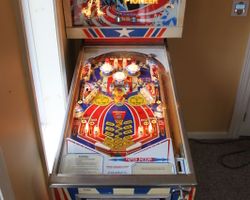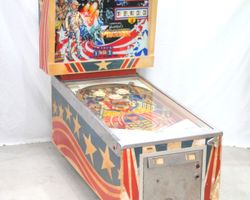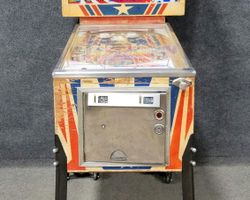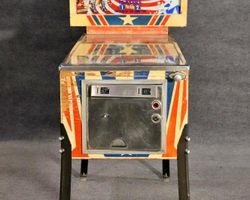Pioneer

Average Prices: USD $300 to $1,000
Produced: March, 1976
Production Run: 3,625 units
Machine Type: Electro-mechanical
Players: 2
Design by: Ed Krynski, Wayne Neyens
Art by: Gordon Morison
The Gottlieb Pioneer pinball machine, released in March 1976, stands as a notable example of the electro-mechanical (EM) era. Manufactured by D. Gottlieb & Co., a company with a rich history in the pinball industry, Pioneer arrived at a significant cultural moment: the United States Bicentennial. While not explicitly named for the bicentennial, its patriotic artwork and the simultaneous release of its 4-player counterpart, "Spirit of 76," firmly link it to this period of national commemoration.
The creation of Pioneer involved several experienced minds within Gottlieb. The design work was a collaboration between Ed Krynski and Wayne Neyens, both prolific designers responsible for many Gottlieb classics. Wayne Neyens also contributed to the machine's core concept. The distinct artwork, central to the machine's Americana theme, was crafted by Gordon Morison. This collaborative effort resulted in a pinball machine that embodied the design philosophies prevalent at Gottlieb during the mid-1970s, emphasizing robust mechanics and engaging playfield layouts.
Gottlieb produced 3,733 units of Pioneer. This production run included 2,550 for domestic sales and 1,075 for export. An additional 108 sample games were produced in 1975, preceding the main production. Pioneer’s place in history is also marked by its connection to "New York," a special 2-player add-a-ball version released in 1976 to celebrate the lifting of long-standing pinball bans in New York City, demonstrating the machine's adaptability and relevance beyond its initial design.
Signature Features and Design
Pioneer is an electro-mechanical machine distinguished by its straightforward yet challenging feature set. The playfield is equipped with two flippers, positioned conventionally at the bottom, offering standard ball control. Three pop bumpers, a staple of EM design, contribute to the erratic and exciting ball movement in the upper playfield. A key characteristic that sets Pioneer apart is the absence of slingshots, a design choice that profoundly influences gameplay flow and player strategy. This omission means the ball reacts directly to bumper hits and flipper control, requiring more precise aiming rather than relying on reactive bouncing.
Central to Pioneer's scoring opportunities are its two banks of four drop targets each, strategically placed on either side of the playfield. These targets are well-angled, encouraging players to aim for specific shots to clear the banks, which are crucial for scoring progression. Five star rollovers are interspersed across the playfield, providing additional points and contributing to bonus accumulation. A kick-out hole in the center of the playfield serves as a collection point, often returning the ball to the flippers or initiating a bonus sequence. The machine also features left and right dual inlanes, aiding in ball retention and setting up shots. A half-moon credit window adds to the classic EM aesthetic, while an end-of-ball bonus system rewards players for accumulated achievements during their turn.
The artwork by Gordon Morison reinforces the machine's theme. The backglass art, in particular, often draws praise for its depiction of American pioneering spirit, featuring scenes that evoke early American history and exploration. This thematic consistency extends to the playfield, where vibrant colors and detailed illustrations create an immersive visual experience that complements the era's design sensibilities.
Playfield and Mechanics
The playfield of Gottlieb Pioneer presents a largely symmetrical layout, a common design philosophy in many EM machines that promotes balanced gameplay opportunities. The design philosophy behind this layout emphasizes direct shots and ball control over chaotic ricochets. With no slingshots to propel the ball laterally, players must rely on precise flipper work and strategic nudging to navigate the playfield and line up shots.
Major shots include aiming for the two four-bank drop targets, positioned symmetrically on the left and right. Clearing these banks is a primary objective, yielding significant points and often enabling other features. The "C" rollover target at the top of the playfield is considered a skill shot, rewarding players who can accurately plunge or flip the ball into its narrow path. The three pop bumpers are situated in the upper-mid playfield, creating an area of lively, unpredictable action. Below them, a center kick-out hole provides a unique interaction point, either returning the ball to play or triggering a scoring event.
The artwork on the playfield integrates seamlessly with the overall patriotic and historical theme. Detailed illustrations of pioneers, covered wagons, and American landscapes adorn the surface, enhancing the player's immersion in the Americana concept. The lighting system, typical of electro-mechanical machines, uses incandescent bulbs to highlight targets and features, creating a warm, inviting glow that complements the classic aesthetic. The visible relays and mechanisms beneath the playfield are a testament to the tactile, mechanical nature of EM pinball, offering a distinct auditory experience of chimes and bells with every score.
Gameplay Dynamics
Pioneer operates as an electro-mechanical pinball machine, meaning its internal logic and scoring are controlled by relays, stepper units, and switches rather than circuit boards and software. This results in gameplay mechanics that are simple in their ruleset but demand considerable player skill. The core progression revolves around accumulating points by hitting targets, particularly clearing the two banks of four drop targets. Each fallen target contributes to the score, and clearing an entire bank often rewards a higher bonus or activates a multiplier.
The scoring system is displayed on mechanical reels, a hallmark of EM machines. Players aim to maximize their score through precise shots and strategic ball management. The "C" rollover target at the top of the playfield provides a valuable skill shot, particularly on the initial plunge, offering a direct path to points. Accumulating points also builds the end-of-ball bonus, which is calculated and awarded once the ball drains, adding a layer of anticipation to the conclusion of each ball.
While EM machines typically do not feature complex modes or multi-stage objectives seen in later solid-state games, Pioneer distinguishes itself through its unique flow. Without slingshots, the game rewards a more deliberate and controlled style of play. Players cannot rely on the chaotic energy of slingshot bounces to reset the ball's trajectory; instead, they must master nudging and flipper control to guide the ball precisely. Strategies often involve systematically clearing the drop targets, then focusing on hitting the pop bumpers for additional points and aiming for the kick-out hole for bonus opportunities. The game's reliance on direct aiming and the satisfying thud of drop targets falling makes for a memorable and challenging experience for those accustomed to the distinct feel of electro-mechanical pinball.
Reception and Legacy
The Gottlieb Pioneer elicits a range of opinions within the pinball community, showcasing its unique position in the pantheon of electro-mechanical machines. Many enthusiasts find it a challenging and even addictive experience, drawn to its fundamental rules and the precision required for high scores. Its symmetrical playfield design is often cited as a strength, offering balanced shot opportunities across the layout. The angles of the drop target banks are well-regarded, providing satisfying and clear targets. The "C" rollover skill shot is a highlight for many, rewarding careful plunges and accurate flipper work. For those who appreciate the era, Pioneer’s simple yet demanding ruleset and classic layout are considered a testament to enduring EM design principles. The thematic artwork, particularly the backglass, and the nostalgic chime and bell sounds characteristic of Gottlieb's EM era, contribute positively to its aesthetic appeal.
However, Pioneer also faces criticism, largely stemming from its defining characteristic: the absence of slingshots. This design choice can lead to a slower-paced game for some players, particularly in the lower playfield once the drop targets have been cleared. Reviewers sometimes describe the game as becoming "boring" or "dull" in these moments, lacking the kinetic energy found in machines with reactive slingshots. The center saucer, or kick-out hole, is occasionally viewed as a point of frustration, perceived as more reliant on luck than skill. Some players also report frequent drains, contributing to a sense of challenge that can tip into frustration. The cabinet construction, utilizing particle board, is also occasionally noted as a lesser quality point compared to other machines of the era.
Despite these mixed views, Pioneer holds a significant place in pinball history, particularly within Gottlieb's extensive EM catalog. It stands as an embodiment of the era's design ethos, emphasizing mechanical reliability and direct player interaction. Its connection to the "Spirit of 76" and "New York" variants further solidifies its historical relevance, illustrating Gottlieb's responsive design and marketing during a pivotal cultural and legislative period for pinball. The absence of slingshots, while polarizing, makes Pioneer a distinct playing experience, forcing players to adapt their strategies and appreciate a different kind of ball flow. This machine remains a point of discussion and enjoyment for those who appreciate the nuanced challenge and enduring charm of electro-mechanical pinball.
Sponsored Links
 Ebay Listings
Ebay Listings
 Auction Results
Auction Results
| Cost | Location | Date |
|---|---|---|
| USD $1,000 |  Florida, United States Florida, United States |
25 June, 2025 |
| USD $854 |  Illinois, United States Illinois, United States |
15 April, 2025 |
| USD $2,200 |  Pennsylvania, United States Pennsylvania, United States |
12 January, 2024 |
| USD $450 |  Maryland, United States Maryland, United States |
07 September, 2023 |
| USD $350 |  New Jersey, United States New Jersey, United States |
28 December, 2022 |
| USD $600 |  New Jersey, United States New Jersey, United States |
27 October, 2022 |
| AUD $2,000 |  Victoria, Australia Victoria, Australia |
26 September, 2021 |
| USD $2,500 |  Florida, United States Florida, United States |
03 July, 2021 |
| USD $700 |  Nevada, United States Nevada, United States |
02 February, 2021 |
| AUD $1,951 |  Queensland, Australia Queensland, Australia |
01 December, 2020 |


Private Policy · Search Website · Contact Us
As an eBay Partner, we may earn a commission from qualifying purchases made through links on this site, at no additional cost to you.
All trademarks and copyrighted materials remain property of their respective owners. All other content copyright 2007 - 2025 Pinpedia.







